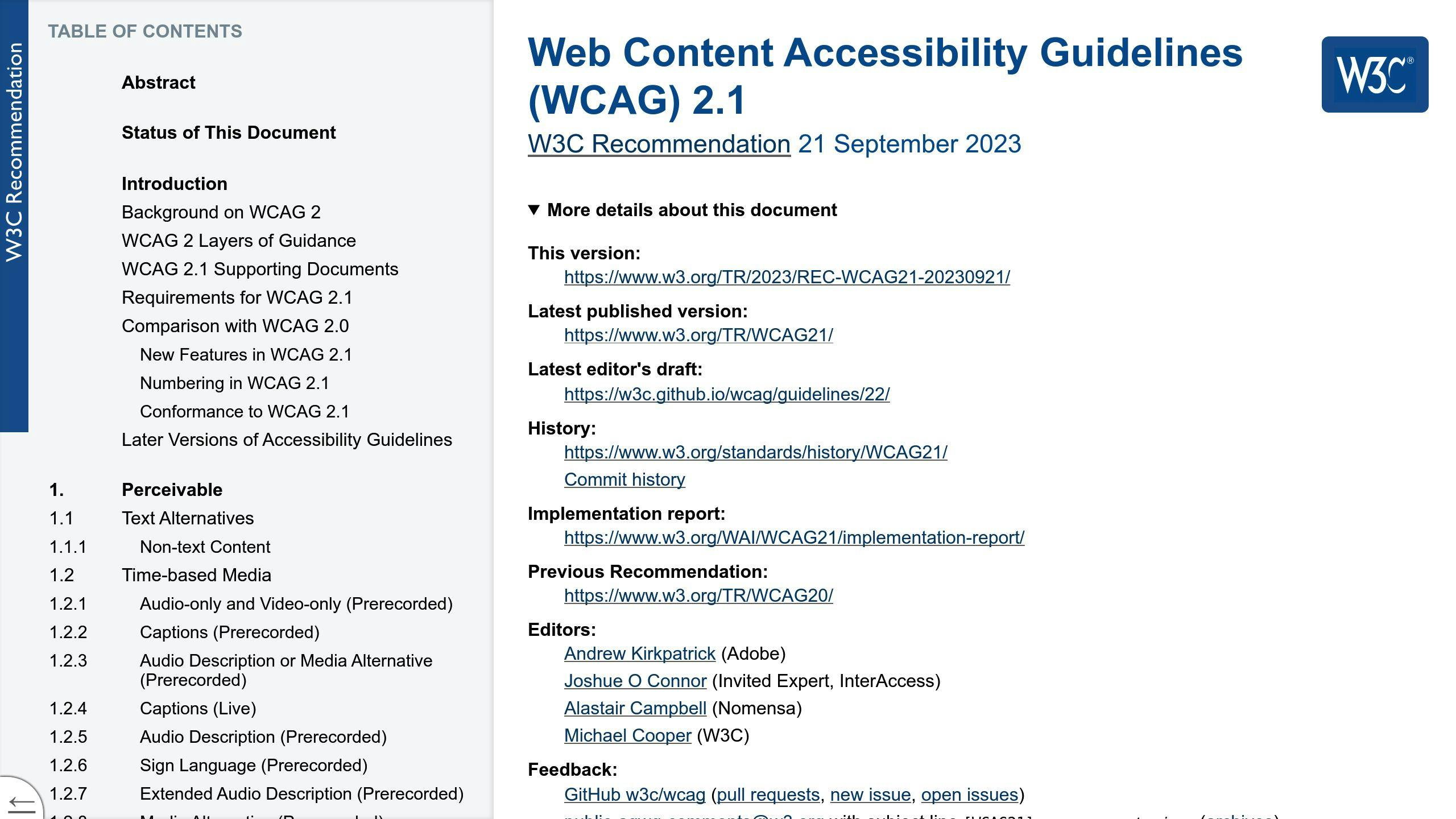Web accessibility is no longer optional - it’s essential. It ensures websites are usable for everyone, including people with disabilities, and benefits businesses by improving user engagement, avoiding legal risks, and expanding market reach.
Key Points:
- What is Accessibility? Creating web experiences that are perceivable, operable, understandable, and robust for all users.
- Why It Matters?
- 71% of users with disabilities leave inaccessible websites.
- Legal risks: Example - Domino’s Pizza faced lawsuits for non-compliance.
- Business benefits: Companies prioritizing accessibility outperform competitors by 28%.
- How to Implement It?
Takeaway: Accessibility improves user experience, reduces risks, and boosts business outcomes. Start by embedding accessibility into your design and development processes today.
Web Accessibility Guidelines | How to Make a Website Accessible?
Accessibility Standards and Tools
The Web Content Accessibility Guidelines (WCAG), created by the World Wide Web Consortium (W3C), serve as the cornerstone for building digital platforms that everyone can use. These guidelines outline actionable steps to ensure websites and applications are accessible to all users.
WCAG and Legal Requirements

WCAG standards are divided into three levels of conformance: A, AA, and AAA. For most businesses, aiming for WCAG 2.1 Level AA compliance is ideal. It strikes a balance between accessibility and practicality.
| Conformance Level | Key Features | Examples |
|---|---|---|
| Level A | Basic requirements | Alternative text, keyboard-friendly navigation |
| Level AA | Improved accessibility | Adequate color contrast, scalable text |
| Level AAA | Highest accessibility | Live captions, sign language interpretation |
Legal frameworks like the EU's Web Accessibility Directive and the ADA often align with WCAG 2.1 Level AA, making it a common target for compliance.
Tools for Accessibility Evaluation
Modern tools make it easier to identify and address accessibility issues. Two popular options include:
WAVE (Web Accessibility Evaluation Tool)
- Highlights problems such as missing alt text, low contrast, and form label errors.
- Provides visual feedback directly on the website.
- Free to use for quick evaluations.
Axe (Accessibility Checker)
- Integrates seamlessly into development workflows.
- Automates testing and offers detailed issue reports.
- Supports continuous integration for ongoing testing.
The accessibility testing market is expected to grow to $1.3 billion by 2027, with an annual growth rate of 13.4% [3]. For startups and visually heavy platforms like travel websites, these tools simplify compliance checks, even during fast-paced development.
A survey by Click-Away Pound found that 71% of users with disabilities leave websites that aren't accessible [4]. This highlights the importance of adopting these standards and tools to not only comply with regulations but also retain users.
Implementing Accessibility in Web Design
Building accessible websites means combining technical know-how with user-focused design. The goal? To create digital spaces that work well for everyone.
Design Principles for Accessibility
Here are some core principles to guide accessible web design:
| Principle | How to Implement | Why It Matters |
|---|---|---|
| Readability | Use high contrast (4.5:1 ratio) and sans-serif fonts sized 16px or larger | Makes content easier to see for all users |
| Navigation | Maintain a clear hierarchy and consistent patterns | Helps users with cognitive challenges navigate smoothly |
| Responsive Design | Ensure layouts adjust to various screen sizes | Allows access across different devices |
"Inclusive design is not just about accessibility, it's about creating products that are usable by everyone." - Microsoft's Principal Designer Kat Holmes
These principles lay the groundwork for accessible design. But how do you put them into action?
Steps for Implementing Accessibility
- Image Optimization: Add descriptive alt text to images, and use ARIA labels for complex visuals like infographics. This ensures users relying on screen readers can understand visual content.
- Interactive Elements: Make sure all interactive components - such as buttons, form fields, and custom widgets - are keyboard-accessible, clearly labeled, and include appropriate ARIA roles.
- Content Structure: Use semantic HTML and maintain a logical heading hierarchy (H1 to H6). This makes content easier to navigate for screen readers and improves overall structure.
Examples for Startups and Travel Websites
The travel industry, with its visually rich interfaces and complex booking systems, faces unique accessibility challenges. Let’s look at Airbnb. In 2024, they introduced voice-enabled search options, which led to a 15% boost in bookings from users with disabilities.
For startups or travel platforms, focusing on these features can make a big difference:
| Feature | Priority Level |
|---|---|
| Alt Text | High |
| Keyboard Navigation | High |
| Color Contrast | High |
| ARIA Labels | Medium |
| Captions | High |
sbb-itb-f11be79
Maintaining Accessibility
Ensuring accessibility isn't just a one-time effort - it’s about keeping it consistent over time. Addressing accessibility during the development phase is far more cost-effective than fixing problems after launch [1].
Regular Accessibility Testing
Different testing methods uncover various accessibility issues, helping maintain compliance across the board. For instance, Microsoft saw a 30% improvement in compliance by combining multiple testing approaches [2].
| Testing Type | Tools | Frequency | Key Benefits |
|---|---|---|---|
| Automated | WAVE, Axe, Lighthouse | Daily/Weekly | Quickly identifies common issues |
| Manual | Screen readers, Keyboard navigation | Monthly | Detects more complex problems |
| User Testing | Focus groups, Surveys | Quarterly | Offers feedback from real users |
"Accessibility demands consistent effort and periodic evaluation." - Lainey Feingold, Disability Rights Lawyer [3]
The BBC managed to cut accessibility complaints by 25% by adopting a systematic testing approach [4].
Accessibility in Development Processes
Testing helps find problems, but weaving accessibility into the development process prevents many of them from showing up in the first place. Automated checks play a key role here.
| Development Stage | Action Items | Tools/Methods | Benefits |
|---|---|---|---|
| Design Review | Check color contrast, typography | Figma Accessibility Plugin | Prevents early-stage issues |
| Development | Run automated tests | Jest, Cypress | Ensures ongoing validation |
| Code Review | Focus on ARIA labels, semantic HTML | Storybook | Improves code quality |
| Deployment | Conduct final audits | Axe-core API | Verifies accessibility pre-launch |
"Embedding accessibility in workflows ensures inclusive products." - Jenny Lay-Flurrie, Chief Accessibility Officer at Microsoft [6]
Organizations with well-defined accessibility strategies achieve 71% higher maturity levels compared to those without structured plans [7]. This highlights how consistent testing and development practices lead to better accessibility outcomes.
Conclusion and Future Considerations
Key Takeaways
Web accessibility is a crucial aspect of creating inclusive digital experiences today. The World Wide Web Consortium (W3C) highlights that following accessibility guidelines improves the experience for all users [8].
"Accessibility is not a feature, it's a requirement. It's about making sure that everyone can use your product, regardless of their abilities." - Léonie Watson, Director of TetraLogical [14]
Accessibility doesn't just enhance user experience - it also brings measurable business benefits.
Why Accessibility Matters for Businesses
The global accessibility market is projected to hit $16.6 billion by 2025, with an annual growth rate of 13.3% [10]. This shows how valuable accessibility is for businesses aiming to stay competitive.
| Category | Impact | Example |
|---|---|---|
| User Engagement | 62% improvement | Companies see higher customer interaction [11] |
| Market Reach | 15% growth | Reflects the global population with disabilities [12] |
The BBC's focus on accessibility led to a 50% increase in accessible content and a 20% rise in satisfaction among users with disabilities [15].
Looking ahead, new technologies like AI-driven testing, mobile-first design, and voice interfaces are reshaping how we approach accessibility. These advancements are particularly useful for startups and travel platforms focused on building inclusive, user-friendly experiences.
FAQs
How do I make my mobile apps accessible?
Creating accessible mobile apps means tackling challenges like small screens, touch-based interactions, and the diverse needs of users with disabilities. Here's how developers suggest addressing these:
| Accessibility Feature | How to Implement | Why It Matters |
|---|---|---|
| Screen Size Adaptation | Use responsive layouts and flexible UI elements | Ensures usability across devices with different screen sizes |
| Color Contrast | Follow WCAG 2.1 guidelines with a 4.5:1 ratio for text | Improves readability, especially in bright outdoor settings |
| Touch Targets | Design buttons and links to be at least 44x44 pixels | Reduces the chance of interaction errors by up to 75% |
For travel apps, it's critical to make booking processes and navigation easy for all users. Focus on mobile-specific challenges rather than general accessibility guidelines to make a bigger impact.
Key areas to prioritize:
- Simplify gestures and streamline data entry. Use clear labels, provide alternative input methods, and prevent errors. Example: Apple's AssistiveTouch enables single-tap alternatives for complex gestures.
- Ensure consistent navigation and layout. Google's Material Design guidelines emphasize predictable patterns and clear visual hierarchies, which are essential for accessibility.
Use testing tools to refine accessibility:
- Automated tools like iOS's Accessibility Inspector and Android's Accessibility Scanner can highlight issues quickly.
- Manual testing with screen readers like VoiceOver (iOS) and TalkBack (Android) helps identify real-world usability problems.
When testing, focus on these aspects:
- Touch interaction accuracy
- Compatibility with screen readers
- Visibility in outdoor conditions
- Usability in different device orientations
"Accessibility goes beyond compliance; it's about crafting seamless experiences for all users." - Android Developers Guidelines [8]
